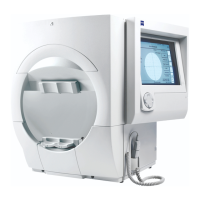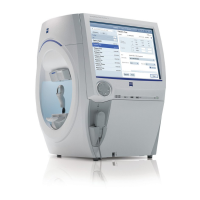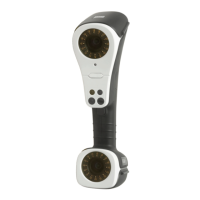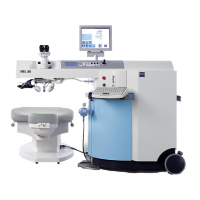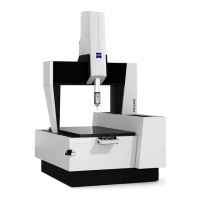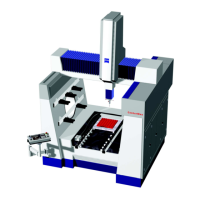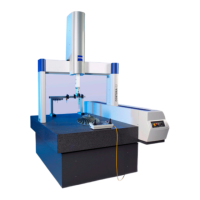Do you have a question about the Zeiss HUMPHREY 720i and is the answer not in the manual?
Explains the concept of visual fields and their importance in eye examinations.
Highlights the key features and benefits of the Humphrey Field Analyzer II.
Provides guidance on how to effectively use the user's manual for learning and reference.
Provides essential warnings and guidelines for the safe operation of the instrument.
Details the various physical parts and modules that make up the HFA II instrument.
Describes external devices like printers and keyboards that can connect to the HFA II.
Outlines the step-by-step procedure for setting up the HFA II instrument.
Provides a basic overview of the HFA II screen layout and its main areas.
Explains the primary screen for initiating tests and accessing system functions.
Covers how to configure instrument settings like language, date, and printer.
Details advanced setup options such as simulation and screen calibration.
Describes how to access on-screen assistance for instrument operation.
Guides on choosing the specific visual field test and which eye to examine.
Details the process of inputting patient demographic and diagnostic information.
Explains the proper use and calculation of trial lenses for patient testing.
Provides instructions on patient positioning, instructions, and environmental adjustments for reliable results.
Explains how to adjust various testing conditions to suit specific patient needs.
Describes different methods for conducting tests, affecting time and precision.
Details the SITA (Swedish Interactive Thresholding Algorithm) testing strategy.
Explains the Blue-Yellow perimetry test and its advantages.
Covers the use of red or blue stimuli for testing on a white background.
Covers initiating a test, displaying status, and changing parameters before starting.
Focuses on using the video eye monitor and gaze tracking for accurate fixation.
Details optional tests like Foveal Threshold and Gaze Track Initialization.
Explains options available during an active test, such as pausing or changing speed.
Outlines actions to take after a test finishes, like saving, printing, or testing the other eye.
Provides a sequential guide for performing a visual field test from start to finish.
Identifies key elements influencing the accuracy and trustworthiness of test results.
Discusses the crucial role of patient cooperation and how to achieve it.
Explains the importance of steady fixation and methods to improve it for reliable results.
Details how incorrect use of trial lenses can impact test reliability.
Covers how to interpret reliability indices like fixation losses and false errors.
Explains how fixation losses are measured and indicate potential issues with patient fixation.
Describes false positive responses as an indicator of poor test reliability.
Details false negative errors and their potential causes, such as fatigue or inattention.
Explains fluctuation values as an index of patient response consistency.
Introduces STATPAC software for expert analysis of visual field test results.
Describes the various formats available for printing threshold test results.
Explains the printout formats used for SITA Standard and SITA Fast tests.
Details the printout formats used for Blue-Yellow perimetry results.
Guides on how to print threshold test results immediately after testing.
Explains the formats used for printing screening test results.
Guides on how to print screening test results immediately after testing.
Covers how to retrieve and print test results stored on disk.
Explains the grayscale representation of visual field defects on printouts.
Describes how to connect to a printer wirelessly using GoPrint.
Lists the main operations available for managing patient data and test files.
Explains how to access and view lists of stored tests from various sources.
Guides on how to choose specific tests from the file directory for operations.
Details core operations like copying, moving, and deleting test files.
Provides recommendations for managing patient data on floppy disks and other media.
Explains the importance of safeguarding patient data and managing databases.
Outlines recommended methods for creating backup copies of patient data.
Covers backing up and restoring instrument settings and custom test patterns.
Provides procedures for recovering from hard drive or floppy disk failures.
Explains how to combine patient data from different sources to resolve inconsistencies.
Describes a utility to remove unassociated patient data and reorganize the hard disk.
Offers methods for maintaining identical patient databases across multiple instruments.
Provides guidelines for properly caring for and handling floppy and magneto-optical disks.
Guides on how to design and create user-defined visual field test patterns.
Explains how to remove custom test patterns from the instrument.
Details how to access and run custom-created visual field tests.
Describes the specific printout formats for custom screening and threshold tests.
Provides an overview of kinetic perimetry and its capabilities on the HFA II.
Guides on how to conduct kinetic perimetry manually, point by point.
Lists and describes the standard, pre-programmed kinetic test patterns available.
Explains how to run kinetic tests in automatic mode for efficiency.
Details a specific kinetic test designed for evaluating visual disability for benefits.
Covers advanced mapping features like scotoma mapping and blind spot mapping.
Guides on how to retrieve and view previously saved kinetic test results.
Explains how to print kinetic test results in various formats.
Details the process of creating personalized kinetic test patterns.
Specific instructions for creating a custom kinetic test for SSA disability evaluation.
Outlines basic guidelines for operating the HFA II to ensure longevity.
Provides instructions on how to clean different surfaces of the instrument.
Guides on how to replace components like the stimulus projection bulb.
Explains how to load paper and operate the attached Printrex printer.
Details the procedure for recalibrating the touch screen for accurate input.
Covers the proper handling and use of floppy and magneto-optical disks.
Lists the technical specifications, dimensions, and electrical requirements of the HFA II.
Compares the availability of various testing features across different HFA II models.
Details the software packages like STATPAC and their availability for different models.
Lists the operator interface, printer support, and patient data input capabilities by model.
Outlines the terms of the product warranty and copyright information.
Specifies the duration and coverage of the manufacturer's warranty for the HFA II.
Details the legal limitations on the seller's liability regarding the product and software.
Provides information on purchasing extended warranty or service agreements.
Refers to the separate warranty provided by Hewlett-Packard for compatible printers.
Presents the legal terms governing the use of the HFA II software.
Outlines the specific rights and restrictions for using the HFA II software.
Provides a visual reference and explanation of the icons used within the HFA II software interface.
Offers tables for converting decibel notation to Goldmann units and apostilbs.
Provides specific conversion values for Blue-Yellow perimetry parameters.
Visually illustrates the layout of points for various threshold test patterns.
Visually illustrates the layout of points for different screening test patterns.
Visually illustrates the layout of points for specialty test patterns like Esterman.
Provides essential preliminary steps and troubleshooting for software installation.
Details the step-by-step process for installing the HFA II software from floppy disks.
Guides on installing optional software features using a separate procedure.
Explains the technical workings of the SITA algorithm and acknowledges contributors.
Explains how SITA optimizes test efficiency by asking targeted questions.
Details how SITA adjusts test speed based on patient responsiveness.
Describes how SITA determines when sufficient information has been gathered at a test point.
Explains SITA's final recalculation of threshold values for improved accuracy.
Provides a comprehensive guide to diagnosing and resolving common HFA II operational issues.
Addresses common problems encountered when initially powering on the HFA II.
Offers solutions for issues related to touch screen responsiveness and calibration.
Provides troubleshooting steps for problems with the patient response button.
Addresses issues related to the display and functionality of the video eye monitor.
Explains how to correct incorrect time or date displays on the instrument.
Covers common problems related to the instrument's inability to print.
Discusses issues related to the format and content of printed test results.
Provides solutions for problems with the blind spot monitoring feature.
Addresses issues related to the initialization and functioning of the gaze tracking system.
Details troubleshooting steps for problems with the head tracking feature.
Covers issues related to the vertex monitoring system and its alarms.
Explains why pupil size might not be displayed correctly on printouts or screens.
Addresses potential compatibility or connection issues with external keyboards.
Covers troubleshooting for trackball or mouse input devices not functioning correctly.
Discusses specific issues related to the Blue-Yellow perimetry mode, like grayscale appearance.
Covers general issues that may occur during the test execution process.
Addresses critical issues related to hard disk failures and data integrity.
Details common problems encountered with floppy disks, including formatting and corruption.
Covers issues related to magneto-optical disks not being recognized or used.
Addresses problems that may occur when transferring data between HFA II units or via serial cable.
Provides guidance on regularly cleaning essential components like the air intake filter and floppy drive.
Explains the concept of visual fields and their importance in eye examinations.
Highlights the key features and benefits of the Humphrey Field Analyzer II.
Provides guidance on how to effectively use the user's manual for learning and reference.
Provides essential warnings and guidelines for the safe operation of the instrument.
Details the various physical parts and modules that make up the HFA II instrument.
Describes external devices like printers and keyboards that can connect to the HFA II.
Outlines the step-by-step procedure for setting up the HFA II instrument.
Provides a basic overview of the HFA II screen layout and its main areas.
Explains the primary screen for initiating tests and accessing system functions.
Covers how to configure instrument settings like language, date, and printer.
Details advanced setup options such as simulation and screen calibration.
Describes how to access on-screen assistance for instrument operation.
Guides on choosing the specific visual field test and which eye to examine.
Details the process of inputting patient demographic and diagnostic information.
Explains the proper use and calculation of trial lenses for patient testing.
Provides instructions on patient positioning, instructions, and environmental adjustments for reliable results.
Explains how to adjust various testing conditions to suit specific patient needs.
Describes different methods for conducting tests, affecting time and precision.
Details the SITA (Swedish Interactive Thresholding Algorithm) testing strategy.
Explains the Blue-Yellow perimetry test and its advantages.
Covers the use of red or blue stimuli for testing on a white background.
Covers initiating a test, displaying status, and changing parameters before starting.
Focuses on using the video eye monitor and gaze tracking for accurate fixation.
Details optional tests like Foveal Threshold and Gaze Track Initialization.
Explains options available during an active test, such as pausing or changing speed.
Outlines actions to take after a test finishes, like saving, printing, or testing the other eye.
Provides a sequential guide for performing a visual field test from start to finish.
Identifies key elements influencing the accuracy and trustworthiness of test results.
Discusses the crucial role of patient cooperation and how to achieve it.
Explains the importance of steady fixation and methods to improve it for reliable results.
Details how incorrect use of trial lenses can impact test reliability.
Covers how to interpret reliability indices like fixation losses and false errors.
Explains how fixation losses are measured and indicate potential issues with patient fixation.
Describes false positive responses as an indicator of poor test reliability.
Details false negative errors and their potential causes, such as fatigue or inattention.
Explains fluctuation values as an index of patient response consistency.
Introduces STATPAC software for expert analysis of visual field test results.
Describes the various formats available for printing threshold test results.
Explains the printout formats used for SITA Standard and SITA Fast tests.
Details the printout formats used for Blue-Yellow perimetry results.
Guides on how to print threshold test results immediately after testing.
Explains the formats used for printing screening test results.
Guides on how to print screening test results immediately after testing.
Covers how to retrieve and print test results stored on disk.
Explains the grayscale representation of visual field defects on printouts.
Describes how to connect to a printer wirelessly using GoPrint.
Lists the main operations available for managing patient data and test files.
Explains how to access and view lists of stored tests from various sources.
Guides on how to choose specific tests from the file directory for operations.
Details core operations like copying, moving, and deleting test files.
Provides recommendations for managing patient data on floppy disks and other media.
Explains the importance of safeguarding patient data and managing databases.
Outlines recommended methods for creating backup copies of patient data.
Covers backing up and restoring instrument settings and custom test patterns.
Provides procedures for recovering from hard drive or floppy disk failures.
Explains how to combine patient data from different sources to resolve inconsistencies.
Describes a utility to remove unassociated patient data and reorganize the hard disk.
Offers methods for maintaining identical patient databases across multiple instruments.
Provides guidelines for properly caring for and handling floppy and magneto-optical disks.
Guides on how to design and create user-defined visual field test patterns.
Explains how to remove custom test patterns from the instrument.
Details how to access and run custom-created visual field tests.
Describes the specific printout formats for custom screening and threshold tests.
Provides an overview of kinetic perimetry and its capabilities on the HFA II.
Guides on how to conduct kinetic perimetry manually, point by point.
Lists and describes the standard, pre-programmed kinetic test patterns available.
Explains how to run kinetic tests in automatic mode for efficiency.
Details a specific kinetic test designed for evaluating visual disability for benefits.
Covers advanced mapping features like scotoma mapping and blind spot mapping.
Guides on how to retrieve and view previously saved kinetic test results.
Explains how to print kinetic test results in various formats.
Details the process of creating personalized kinetic test patterns.
Specific instructions for creating a custom kinetic test for SSA disability evaluation.
Outlines basic guidelines for operating the HFA II to ensure longevity.
Provides instructions on how to clean different surfaces of the instrument.
Guides on how to replace components like the stimulus projection bulb.
Explains how to load paper and operate the attached Printrex printer.
Details the procedure for recalibrating the touch screen for accurate input.
Covers the proper handling and use of floppy and magneto-optical disks.
Lists the technical specifications, dimensions, and electrical requirements of the HFA II.
Compares the availability of various testing features across different HFA II models.
Details the software packages like STATPAC and their availability for different models.
Lists the operator interface, printer support, and patient data input capabilities by model.
Outlines the terms of the product warranty and copyright information.
Specifies the duration and coverage of the manufacturer's warranty for the HFA II.
Details the legal limitations on the seller's liability regarding the product and software.
Provides information on purchasing extended warranty or service agreements.
Refers to the separate warranty provided by Hewlett-Packard for compatible printers.
Presents the legal terms governing the use of the HFA II software.
Outlines the specific rights and restrictions for using the HFA II software.
Provides a visual reference and explanation of the icons used within the HFA II software interface.
Offers tables for converting decibel notation to Goldmann units and apostilbs.
Provides specific conversion values for Blue-Yellow perimetry parameters.
Visually illustrates the layout of points for various threshold test patterns.
Visually illustrates the layout of points for different screening test patterns.
Visually illustrates the layout of points for specialty test patterns like Esterman.
Provides essential preliminary steps and troubleshooting for software installation.
Details the step-by-step process for installing the HFA II software from floppy disks.
Guides on installing optional software features using a separate procedure.
Explains the technical workings of the SITA algorithm and acknowledges contributors.
Explains how SITA optimizes test efficiency by asking targeted questions.
Details how SITA adjusts test speed based on patient responsiveness.
Describes how SITA determines when sufficient information has been gathered at a test point.
Explains SITA's final recalculation of threshold values for improved accuracy.
Provides a comprehensive guide to diagnosing and resolving common HFA II operational issues.
Addresses common problems encountered when initially powering on the HFA II.
Offers solutions for issues related to touch screen responsiveness and calibration.
Provides troubleshooting steps for problems with the patient response button.
Addresses issues related to the display and functionality of the video eye monitor.
Explains how to correct incorrect time or date displays on the instrument.
Covers common problems related to the instrument's inability to print.
Discusses issues related to the format and content of printed test results.
Provides solutions for problems with the blind spot monitoring feature.
Addresses issues related to the initialization and functioning of the gaze tracking system.
Details troubleshooting steps for problems with the head tracking feature.
Covers issues related to the vertex monitoring system and its alarms.
Explains why pupil size might not be displayed correctly on printouts or screens.
Addresses potential compatibility or connection issues with external keyboards.
Covers troubleshooting for trackball or mouse input devices not functioning correctly.
Discusses specific issues related to the Blue-Yellow perimetry mode, like grayscale appearance.
Covers general issues that may occur during the test execution process.
Addresses critical issues related to hard disk failures and data integrity.
Details common problems encountered with floppy disks, including formatting and corruption.
Covers issues related to magneto-optical disks not being recognized or used.
Addresses problems that may occur when transferring data between HFA II units or via serial cable.
Provides guidance on regularly cleaning essential components like the air intake filter and floppy drive.
| Brand | Zeiss |
|---|---|
| Model | HUMPHREY 720i |
| Category | Measuring Instruments |
| Language | English |



